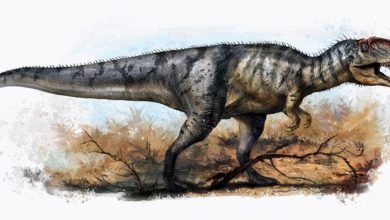Yosemite National Park
Yosemite National Park – a basin of primeval nature
Home of Indian spirits
One of the places on Earth whose present form is closely related to processes related to water. The primal power of water is still visible in this National Park today. We admire there, thousands of lakes and ponds and 2600 km of streams.
Most of the area of the Park is nature untouched by human hands, however, fires regularly breaking out destroy large fragments of land covered with ancient redwoods, Douglas firs and pines. Here is the land teeming with the life of its original inhabitants and the home of Indian spirits – Yosemite.

Location
The Sierra Nevada is a mountain range in North America, located in the state of California. In the central part of the range is the Yosemite National Park. It is adjacent to three large primeval forest formations: Ansel Adams Wilderness (to the southeast), Hoover Wilderness (to the northeast) and the Emigrant Wilderness (to the north).
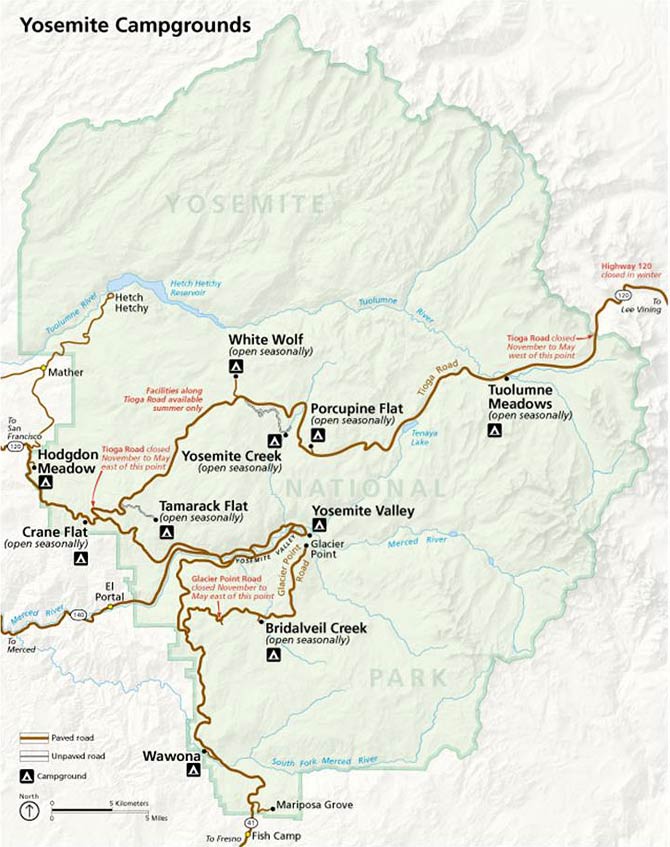
Establishment of the Park
The establishment of the National Park resulted directly from the threats that lay in wait for the local nature. Many flocks of sheep were grazed in the meadows of Yosemite and beautiful redwoods were cut. A certain John Muir – a Scottish-American naturalist and philosopher, was one of the promoters of the creation of the local protected area. Muir, along with Robert Johnson, an American writer and diplomat, stood before Congress with a request to create a law to protect Yosemite. On October 1, 1890, their request went into effect – Yosemite National Park was established.
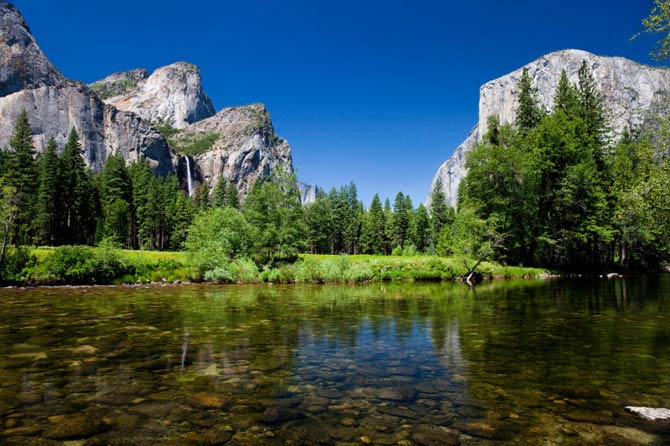
Basic data
The total area of the Park is 3,029 km2 (748,436 acres; 1,169 sq mi). The territory of Yosemite includes thousands of beautiful lakes and ponds, miles of streams and hiking trails.
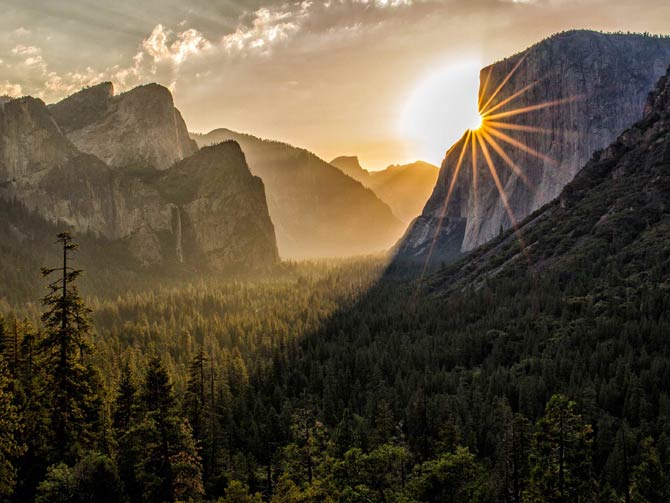
Climate
Winters are mild, but rainfall is the most intense during these winters. The remaining months of the year are almost completely dry. Snow usually accumulates throughout the winter, falling until March or even April. These types of weather conditions are typical of the Mediterranean climate, which is a type of subtropical climate.
The average daily temperature in the higher areas (approx. 2,600 m (8,600 feet) above sea level) is 4-12°C (25 – 53 °F). In the lower parts, the temperature increases – at 1560 m (5,130 feet) above sea level reaches 19 °C (67 °F), while at an altitude of approx. 1200 m (3,960 feet) above sea level ranges from 8 to 32 °C (46 to 90 °F).
In summer, the air is dry and hot, with frequent summer storms. During this time, at altitudes above 2400 m (8,000 feet) above sea level, there is still snow. Adding low air humidity to it, we get thunderstorms – the most common cause of fires in the Yosemite National Park.

Natural environment
We meet the forest formations characteristic of North America, called chaparral (a shrubland or heathland plant community). In addition, you can admire stretches of pine and fir forests, as well as magnificent redwoods. The clusters of trees cross the alpine meadows.

Waterfalls – houses of ghosts
Yosemite is a place concentrating a large number of waterfalls in a relatively small area. Of course, this is due to the terrain – numerous steep slopes, U-shaped valleys and other glacial (glacial) forms. Most waterfalls can be observed in April, May and June, i.e. during the thaw. In addition to those flowing all year round, we will also meet hundreds of impermanent, cyclically appearing waterfalls.
One of the highest waterfalls in North America – Yosemite Falls is located in the territory of the Yosemite National Park. It reaches a height of 739 m (2,425 feet), but it is not the most popular waterfall in the Park. In this respect, the winners are Ribbon Falls, the highest single-stream (highest single vertical drop) waterfall in North America (491 m; 1,612 feet), and Bridalveil Falls, which is 188 m (617 ft) high, and operates all year round. The original Ahwahnechee tribe, who in the past inhabited the Yosemite Valley, believed that this last waterfall was home to the vengeful spirit of Pohono (“Spirit of the Puffing Wind”), guarding the valley entrance. They also believed that when leaving the valley it was not allowed to look at the waterfall. Whoever did this was cursed.
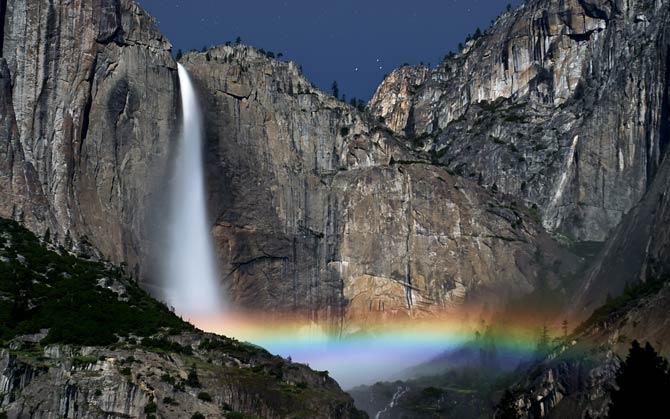
Fires
The paradox is that fires regularly break out in a park full of water reservoirs. After burning the old, dead plant shell, conditions for the growth of new, young plants are created. As ecological as it sounds, fires are fundamentally damaging to the flora and fauna of Yosemite National Park. In addition, they force the park overseers to close certain parts of the park to tourists for a while, which in turn entails huge financial losses.
One of the most destructive fires was the so-called Rim Fire. It exploded on August 17, 2013, and was completely extinguished on October 24. During a fire that lasted several weeks, over 1000 km2 of wild vegetation went “in smoke”. It was the third-largest fire in California history. Fires
The paradox is that fires regularly break out in a park full of water reservoirs. After burning the old, dead plant shell, conditions for the growth of new, young plants are created. As ecological as it sounds, fires are fundamentally damaging to the flora and fauna of Yosemite National Park. In addition, they force the park overseers to close certain parts of the park to tourists for a while, which in turn entails huge financial losses.
One of the most destructive fires was the so-called Rim Fire. The fire started on August 17, 2013, it was completely extinguished only on October 24. During a fire that lasted several weeks, over 1000 km2 (257,314 acres; 402.053 sq mi) of wild vegetation went “in smoke”. It destroyed nearly $2 billion in assets and revenue. Rim Fire was the third-largest fire in California’s history. As of 2018, the Rim Fire was California’s fifth-largest modern wildfire

Yosemite Firefalls
An unusual and rare phenomenon that occurs in Yosemite National Park is called firefall. However, these are not falling lava flows, but a properly sunlit waterfall. The last time this phenomenon occurred in February 2016.
Firefall occurs when the sun’s rays reflect off Horsetail Falls and there is still a large amount of snow on the top of the mountain. High air temperature causes it to melt. Snow turns into water falling from the rock threshold. For the sun to properly illuminate the waterfall, the sky must be cloudless. So in order for firefall to be created, many conditions must be met simultaneously. For this reason, the described phenomenon is very rare.

Animals
Yosemite National Park is home to 250 species of vertebrates (mammals, amphibians, reptiles, birds). The most recognizable species are black bear, coyote, raccoon, mountain kingsnake, Gilbert’s skink, white-headed woodpecker, bobcat, river otter, gray fox, red fox, brown creeper, two species of skunk, cougar, spotted owl, and a wide variety of bat species.
Going higher in elevation, the coniferous forests become purer stands of red fir, western white pine, Jeffrey pine, lodgepole pine, and the occasional foxtail pine. Fewer wildlife species tend to be found in these habitats, because of their higher elevation and lower complexity. Species likely to be found include golden-mantled ground squirrel, chickaree, fisher, Steller’s jay, hermit thrush, and northern goshawk. Reptiles are not common, but include rubber boa, western fence lizard, and northern alligator lizard.

Plants
Primary forest formations include mixed forests, consisting of Douglas firs, California firs, Cedar trees, sugar pines and yellow pines. In several parts of the Park, there are giant sequoias. One of the most impressive mammoth representatives in Yosemite National Park is the Grizzly Giant, reaching 63.7 meters (209 ft) in height and 7.8 meters (25.5 ft) diameter 1.5 m above the base. In addition to huge redwoods, we also find magnificent oaks.

Detailed data / dimensions
Yosemite National Park
- Area: 3,027.19 km2 (748,436 acres)
- Established: October 1, 1890
- Main attractions: Waterfalls, including one of the highest in North America – Yosemite Falls and North America’s highest single stream waterfall – Ribbon Falls, hiking, winter sports (including cross-country skiing)
- Records: one of the largest and least dispersed habitats (habitats, biotopes) of Sierra Nevada
- Highest peak: Mount Lyell (3,997 m; 13,120 ft above sea level)
- Largest lakes:
- Eleanor
- Merced
- Mirror
- Tenaya
- Main river: Merced
- Annual visitors: 4,422,861 (in 2019)
- At Yosemite National Park there is:
- 2,600 km (1615 mi) of streams
- 1,300 km (807 mi) of mountain trails
- 560 km (347 mi) of roads.

Yosemite National Park – interesting facts
- Yosemite is a word derived from the Miwok language (Yohe’meti) – Californian Indian tribes. It means “those who kill”, and was related to the tribes expelled or killed by the soldiers of the Mariposa Battalion. Previously, the area of the Park was called Ahwahnee – “big mouth”.
- The area of Yosemite National Park is similar to that of Rhode Island – one of the New England regions in the USA.
- Yosemite Valley (Yosemite Valley) accounts for about 1% of the Park’s area, but the largest number of tourists visiting the National Park come here.
- Almost 95% of the Park’s area is made up of primary forests – forest formations not transformed by man.
- Yosemite’s black bears were once famous for their ability to break into parked cars and steal food.
- Increasing air pollution causes damage to the tissues of giant sequoias. For this reason, they are more prone to disease and insect infestation.


















